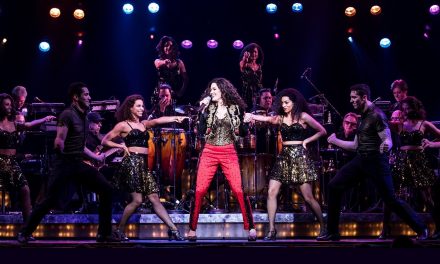Walking into the deconstructed Sharon Disney Lund Dance Theater at California Institute of the Arts, I’m hit with honest artistic energy, hungry to showcase itself. With lots of undergraduate and graduate students parading around, chatting with friends, laughing with professors, I felt immediately comfortable and safe in my freedom of thought as I took my seat on one of the four edges of the stage. The theater was set with large and hollow rectangular arches, similar to that of doorways, that seemed to be a dark brown/gray in color with a chalky white pattern. Five performers, Grace Major, Chantel Murphy, Alicia Pak, Ashley Sartell, and Mao Tokunaga, fashioned themselves standing underneath them, huddled in a silent sway stance as the audience quietly took their seats. They’re wearing a dull lavender/gray shirt with various holes cut out near the collarbone and mid-section, and full legged pants near the same color. With brilliant lighting by Claire Chrzan, and music composition by Squash & Biscuit (Brian Griffith and Shuwen Zhao) I N T E R I O R begins.

CalArts Sharon Disney Lund School of Dance – INTERIOR by Taylor Donofrio – Squash Biscuit composer duo Brian Griffith and Shuwan Zhao – Photo by Rafael Hernandez
Much to the audience’s surprise, the bulky rectangular archways are much lighter than they look! The dancers begin moving them by holding the weight on their backs, dragging them with their arms, lifting them down towards the Marley floor and burrowing inside. This was such symbolic choreography by the brilliant Taylor Donofrio, as each dancer handled the weight differently, which resonated with each person watching, as we all carry the weight of life in many different manners. We hold stress, and heaviness not only in parts of our own body, but with different force and pressure. The same arched structure was heavier or lighter depending on what performer you were attached to watching. For those dancers burying their bodies inside the cardboard, we saw a want to live inside it, and others trying to escape the borders. Some felt at ease with their new burden and surroundings, while others felt trapped or almost immobile making the similar structures take on a new kind of individual wall space: a home, or a prison. With scenic design by Yuki Ding, the arches were light enough to move but not light enough to knock over, much like the leverage and anxiety we all feel in our day to day lives. Another beautiful representation of weight through the collaboration of Donofrio and Ding, was the subtle chalky substance covering the arches. As the movers placed the props on various areas of their body, the chalk would rub off on their clothing representing a new mark, the way a cut or a scar would forever change a person.

CalArts Sharon Disney Lund School of Dance – INTERIOR by Taylor Donofrio – (L-R) Ashley Sartell, Grace Major, Alicia Pak, Mao Tokunaga – Photo by Rafael Hernandez
There always seemed to be one dancer amongst the group at any given moment that rejected the patterns of confinement. With brilliant geometric movement patterns, we saw the dancers pulling their hair above their heads, or pressing their hair against their face, with arms in front, hands wringing, fists to open to fists closing…and this would repeat in almost a ceremonial practice. We also saw release between several moments of contact improvisation, as the dancers held open palms up towards the sky and worked together to create a new interior that could fit two or three bodies at a time.

CalArts Sharon Disney Lund School of Dance – INTERIOR by Taylor Donofrio – (L-R) Grace Major, Alicia Pak – Photo by Rafael Hernandez
Near the end of the piece, as four of the five dancers unify in movement, we see dancer Chantel Murphy move several cardboard arches towards a corner of the stage. She lays one across the other, creating a bulky structure of severe heaviness. Murphy, a key mover in this piece, seemed to always be on the outside, a loner to the pack of unison at many given moments. She was powerful and poignant in her stance to always knock down structures and make new interiors for not only herself, but for the group which was especially specific in the end. As the other four movers worked in parallel patterns of soft choreography on the opposite side of the stage, Murphy began pulling light brown art paper from the bottom of the built up archways and throwing them overhead like clothing from a drawer. In speaking with Donofrio afterwards the paper, “represents a light and airy form of the cardboard composition.” I N T E R I O R’s end mirrored our own restrictions, maybe personal maybe covid related, as we got rid of borders and normalized new freedoms again. Donofrio quoted, “we built this work over the past 6 months…its evolving structure becoming pertinent for the work…feels very fitting that this work represents not only parts of my personal journey, but also my journey here at this unique institution”. All the dancers had to dance through the professional regulations that would come with an institution like CalArts through Covid-19.

CalArts Sharon Disney Lund School of Dance – INTERIOR by Taylor Donofrio – Grace Major, Chantel Murphy, Ashley Sartell – Photo by Rafael Hernandez
Having watched Donofrio’s dances for many years in New York, I am always baffled by her intuitive ability to make me feel like my bone structure has movement of its own. Often coming from a structural and graphic point of view, she’s able to create a meditative environment where I can check in with my own body while watching others. Donofrio has a strange handle on the audiences she creates for; generating a moody presence that makes you feel something soft enough to escape to, but not loud enough to leave for. You’re held in this brilliant choreographic transportation of thought. I N T E R I O R left the audience with a sigh of relief, like someone else finally understands what the strains of limitations from the psyche can have on the physical body. But also reminding us that all rules and regulations are simply doorways we need to walk through and depending on our perspective…we can make them heavy on our hearts or light enough to carry.
To learn more about dance at CalArts, please click HERE.
Written by Grace Courvoisier for LA Dance Chronicle.
Featured image: CalArts Sharon Disney Lund School of Dance – INTERIOR by Taylor Donofrio – (L-R) Ashley Sartell, Alicia Pak, Chantel Murphy, Grace Major – Photo by Rafael Hernandez







